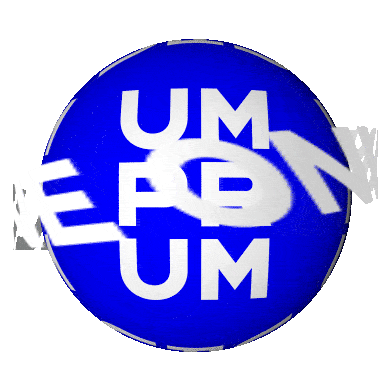


Grow together. With Aleš Hnátek, Magdalena Šťastníková and Michal Králíček on mutual interdisciplinary dialogue and cooperation in art and design, Part I.
Michal Králíček from the Studio of Photography I, Magdalena Šťastníková from the Studio of Concept – Object – Meaning (K.O.V.) and Aleš Hnátek from the Fashion and Footwear Design Studio combines friendship and artistic sensibility, which have grown into a collaboration between photography, jewelry, and clothing into joint projects on the border of art and design. Their creative synthesis follows the general tendency of the young generation to deviate from individualistic performances and seek common ground across studios, media, and topics. In a two-part interview with Magdalena, Aleš, and Michal, we talked about the various aspects of cooperation that accompany UMPRUM students and graduates against the background of implemented projects and the experience of beginning professionals. In the first part, we focus on the reflection of current work, the dialogue of disciplines, and the pillars of successful interdisciplinary practice.
Text: Veronika Soukupová
AH = Aleš Hnátek
MK = Michal Králíček
MŠ = Magdalena Šťastníková
Each of you works in a different artistic field, and yet your work works in symbiosis. How did this creative connection come about?
AH: We first met as part of Michal's bachelor's degree in 2020. At that time, Michal approached me and Magda to complete his final performance with clothing and jewelry. Michal and I already knew each other before from photo shooting a lookbook, but this was the first time we all created something together. In each part, we each worked on a common topic that concerned (non) display, but Michal left us a free hand in the implementation. When we saw everything together during the fitting, we were glad that all of it harmonized so well and that the whole thing came together. We wanted to develop it further. At the same time, we realized how important trust is in such cooperation and how it obliges each of us to perform well because one does not want to disappoint the other.

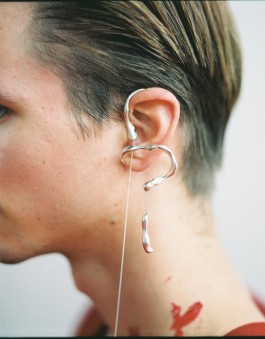

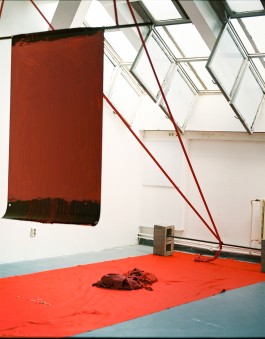
Bakalářská práce Michala Králíčka z Ateliéru fotografie I na UMPRUM s oděvy Aleše Hnátka a se šperky Magdaleny Šťastníkové, 2020
(foto Michal Králíček)
Although we live in a time of hyperindividualism, I have a feeling that the young generation of artists is turning away from this model and, on the contrary, looking for collaborative practice. The annual exhibition UMPRUM in 2020 with the title Přihraj! (Pass it on!), discussed aspects of student cooperation during project creation was also a confirmation. How do you perceive it? What does interdisciplinary dialogue bring to you as a creator?
MŠ: It is extremely inspiring for me to see the process of how another person creates their work. At the same time, it gives me a different opinion and perspective on my work, which is refreshing.
AH: What I like most about it is that people within collaborations can grow together and share the joy of work and outcome. The work is then much more complex.
MK: I actually got into fashion this way - I had a girlfriend who studied fashion and pulled me into it. I used to perceive it quite superficially, purely visually, but gradually I began to perceive that fashion is deeper and carries meanings and thoughts, and that is why I wanted to take pictures of it. At the same time, as Magda says, an interdisciplinary dialogue will give you new perspectives, which is exactly what is happening to me.
Other projects followed up on the cooperation within Michal's diploma thesis. How did they go?
MŠ: The bachelor's project was followed by Aleš's show at the Van Graaf Junior Talent competition. That was a slightly different case - I didn't make jewelry for this purpose, but Aleš approached me before the show if I by chance had something ready. I chose jewelry that was suitable for this and was completed by the outfits. And besides, I played with metal elements, for example, I made an ear for a purse.
AH: Together we created the complete styling. Michal then shot photos for the lookbook, which resulted in photos with Veronika Čechmánková (editor's note, photographer, and interdisciplinary artist who works with Aleš Hnátek as a model) in Stromovka. Winning the competition meant that I was able to implement a new collection in a short time and then present it at the autumn MBPFW. During preparations, we resumed our cooperation. I knew from previous projects that our things worked great together aesthetically, so it was a clear choice.
MŠ: It was already there that I created jewelry, especially for Aleš's collection. At the same time, we agreed that Michal will take pictures of the show backstage. During the preparations, we met together, we showed the process of our things, we discussed their appearance and the overall atmosphere that it should create together. Aleš's things inspired me on their own. We also decided on the color of the material and on the cuts of fabric, so that I could anticipate where on the body there would be space for jewelry. In the end, the whole thing arose very emotionally, thankfully moments of chance and surprise were not lost and pushed the work to another level. Before the fashion show, we styled the garments exactly to the models, a lot of things were finalized there.
AH: It was hectic, but thanks to that it had such lively energy and predation, which was then reflected in the whole show.
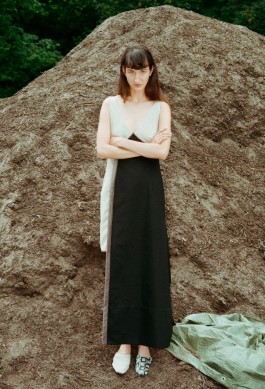
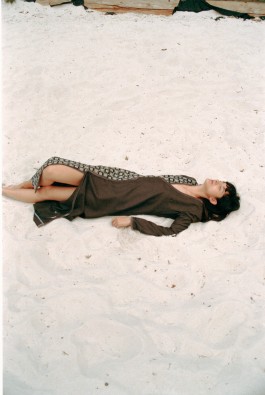

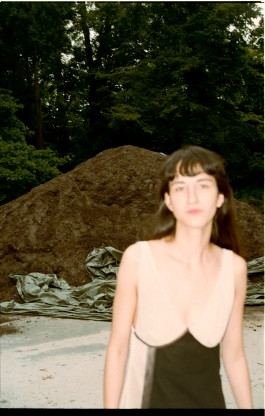
Lookbook oděvní kolekce Aleše Hnátka na modelce Veronice Čechmánkové (foto Michal Králíček)

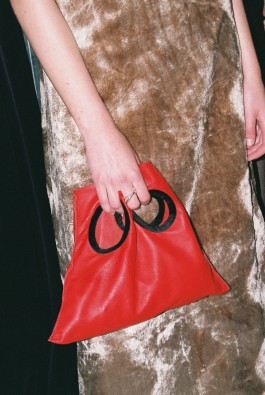
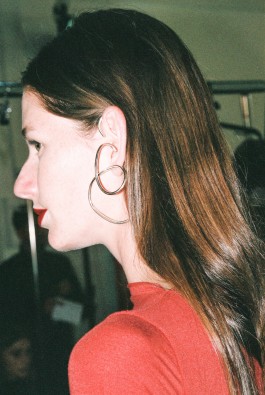
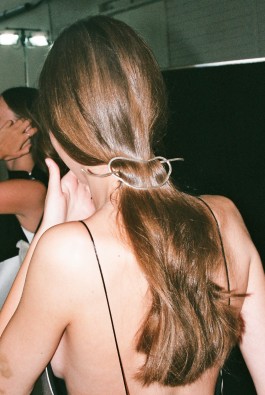
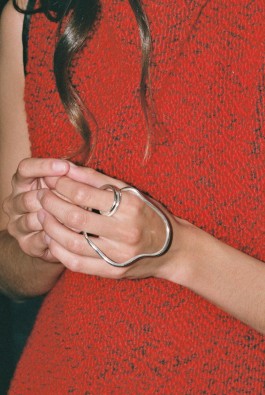

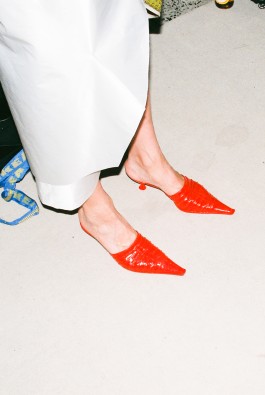

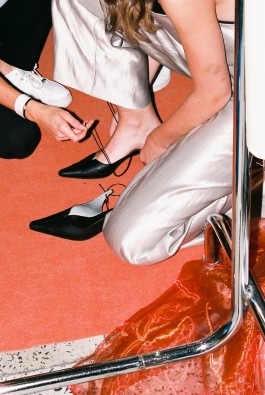
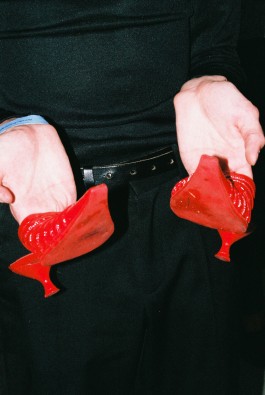

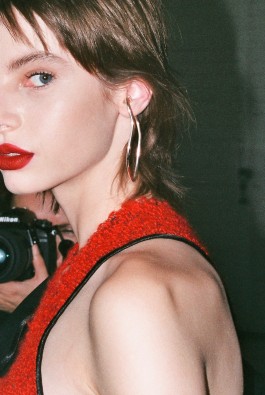
Fotografie Michala Králíčka z backstage přehlídky Aleše Hnátka na Mercedes Benz Prague Fashion Week 2021. Oděvní kolekci doplnily šperky Magdaleny Šťastníkové, foto Michal Králíček
What role did photography play in this collaboration? Official photos were taken from the catwalk by the organizers, as far as I know, your projects, it was about something more than capturing a static record of the outfits…
AH: Backstage, Michal photographed preparation and styling. Unlike the official photos, he managed to capture the atmosphere of the fashion show, details, and dialogue of materials. The photos carried the essence of aesthetics, which we have in common and are evident in all our projects. Then we photographed the campaign for this collection in The New Stage of the National Theater.
MŠ: Michal took into account our overall cooperation during the backstage photoshoot. He created beautiful photos that capture the jewelry, how they function with the clothing and body, and the moment of putting them on. The jewelry plays an important role in the show, but they are difficult to see in the official photos - outfits are captured only from a distance and from the front.
MK: I shot both on analogue with flash. This gave the photos a certain brutality, which was desirable for me. Taking pictures on analogue is exciting in itself, one does not have such control over the creation of images, because one does not see them on the screen. Then, when I get the developed photos back from the lab, I feel like I'm the designer of the photos and now I finally have the opportunity to see and perceive them in their materiality. In addition to the camera, I have to trust myself a lot - I had 15 minutes backstage to take the picture as best I could, and at the same time I was limited by the number of pictures. It requires extreme concentration and deliberation.
I would say that you are also united by crossing, or more precisely by erasing, the boundaries between applied and fine art. When photographed jewelry, and clothing often turn into fine art objects, photography is not a neutral record of reality, but rather an artistic interpretation. How do you perceive it? Did the studios in which you studied lead you to this approach?
MŠ: The abbreviation of our studio K.O.V. means Concept Object Meaning. In principle, it is based on and welcomes an overlap into free conceptual expression. We are able to create work on the border of fine art objects, design, and jewelry. But it has its limits, it is necessary to respect some set boundaries of the studio, such as materiality or work with metal. I would like to move my projects to an even freer form of creation, combining different media, but I am not sure how the heads of the studio and the committee would accept it.
AH: In the studio, we are also guided quite conceptually, but always staying within the framework of the garment, we probably couldn't abandon the garment altogether. But assignments go beyond the looser artistic concept of design - it is welcome when garments sometimes overlap into object form. At the same time, I feel that if we came up with an idea of where we want to push it or if we wanted to include another medium, as in the case of digital fashion, the head of our studio, Liběna Rochová, would accept it.
MK: As a graduate of the Department of Fine Arts, I have a different experience, because we usually did not work with any specific assignment. However, my work always emerges from the dissension between fine and applied art. Although my first final projects were not about clothing, when I look back, I was interested in principles similar to those of today. In general, I am bothered by the limits that are placed on fashion photography as an applied discipline, which is why I try to break free of them.
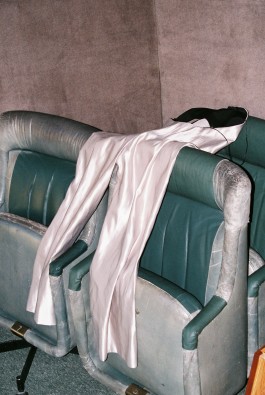
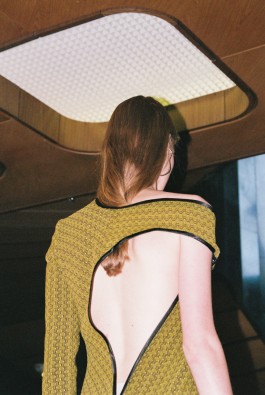

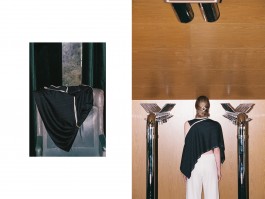

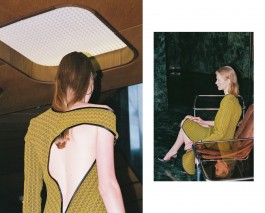
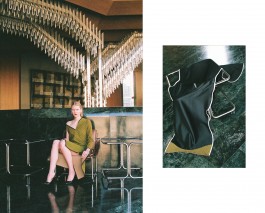
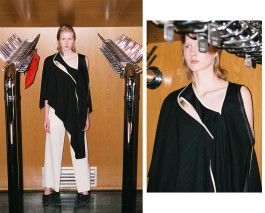
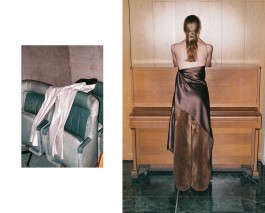
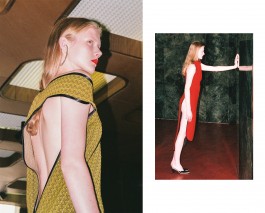
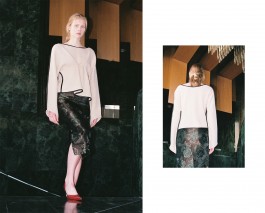

Lookbook ke kolekci oděvů Aleše Hnátka a šperků Magdaleny Šťastníkové, foto Michal Králíček
The body of the wearer or the spectator, which is a priori connected with clothing, jewelry and fashion photography, also enters into the dialogue at one point. In your projects, however, it is no exception that the body is missing in the photographed installation. How do you work with the motif of corporeality and wearer in your work?
MK: I have such a specific attitude. As you mentioned, I often don't take pictures of clothes on the wearer, because the presence of the body affects the photograph very much. Sometimes I wonder how the clothes look on the body, but other times I want to free myself of it. It's a different way of working. I don't have to have a production team around me and photoshoots become an intimate and introspective affair. I look for a location myself, shape the clothing how I need, and treat the garment with my intentions.
MŠ: I really enjoy the interaction between the jewelry and the wearer. At first glance, some of my things do not reveal how to put them on - when you find out, they merge with you. After all, the body is what makes a piece of jewelry, it always has to communicate with the body in some way. I also like to work with the moment of when the jewelry crosses the silhouette of the body.
AH: The body is essential in my work, it is the basic building block. At the same time, I really enjoy Michal's photographic process, in which the clothing takes on a completely different dimension. Like Magda, I like overlaps, in a specific situation, clothing becomes an abstract object. I perceive communication with the body in a similar way. One dress I made is not entirely clear on how to put it on. It happened that the wearer wore the garment in a different way than I intended, but it seemed great to me. Things this way gain a new dynamism.
Do you plan to further develop your cooperation in work?
AH: I hope so. I'm even counting on it.
MŠ: I think it works great for us and I also hope that we will continue to do so. At the same time, this does not necessarily mean that the cooperation will always be the same. As we progress, it will evolve with us.
MK: When you do more of those things together, you can play with it in different ways, experiment, try something new, reach for different inspiration or color. So far it has always been very intuitive, even basal, next time we can start from some research or mood board. I would like to deepen the interaction between the different areas.
Continuation of the interview coming soon at: online.umprum.cz.
Magdalena Šťastníková (*1994) se šperkařskému řemeslu věnuje od střední školy. Po dokončení oboru Povrchové zušlechťování kovu a bižuterie (dnes Design šperku) na SUPŠ v Jablonci pokračovala na Pedagogickou fakultu UK a současně rozvíjela šperk na Scholastice. K práci s kovem se vrátila při magisterském studiu na Katedře užitého umění FUD v Ústí nad Labem a v Ateliéru K.O.V. na UMPRUM, které aktuálně dokončuje. Magdin přístup k tvorbě vychází z pocitů a emocí, které jsou reflektovány v abstraktně tvarovaném kovovém materiálu. V médiu šperku zkoumá možnosti interakce s nositelem a hranice lidského těla, které často přesahuje. Nezbytnou součástí Magdiny tvorby je bezprostřední kontakt s materiálem a s tím související kvalitní řemeslné zpracování.
Aleš Hnátek (*1995) oborové studium zahájil na Střední uměleckoprůmyslové škole v Uherském Hradišti, kde se věnoval designu a modelářství obuvi. Po absolutoriu pokračoval do Ateliéru designu oděvu a obuvi na UMPRUM, kde na profesionální úrovni rozvíjí vlastní návrhářskou tvorbu. Aleš ve svém přístupu vychází z vlastní intuice a citu pro detail, klade důraz na precizně zvládnuté řemeslo a principy udržitelnosti. Do svých oděvů a doplňků začleňuje fragmenty nalezených starožitných látek, které do uměřených elegantních forem vnášejí prvky snovosti a atmosféru své doby. V roce 2021 získala Alešova práce ocenění v soutěži Van Graaf Talent Junior. Autorská kolekce doplněná o šperky Magdaleny Šťastníkové byla ve stejném roce prezentována na Mercedes Benz Prague Fashion Week.
Michal Králíček (*1991) je absolventem Ateliéru fotografie I (nyní Ateliér volného umění IV) na UMPRUM, kam pokračoval po studiu na Vyšší odborné škole grafické v Hellichově ulici v Praze. V bakalářské práci se zabýval vztahem oděvu, šperku a těla a zkoumal hranice (ne)zobrazivosti fotografie, což jsou témata, které se prolínají celou jeho dosavadní tvorbou. Michal ve své práci osciluje mezi volným a užitým uměním, které je na umělecky laděných fotografiích přítomno skrze fotografované objekty. Užitkovost předmětů je zároveň zpochybňována způsobem jejich instalace. Michal Králíček jako fotograf pravidelně spolupracuje s módními návrháři a se studenty volného a užitého umění a je svébytným přínosem české módní fotografii.
Veronika Soukupová (*1997) je absolventkou bakalářského oboru dějiny umění na Filozofické fakultě UK a aktuálně pokračuje v magisterském studiu na Katedře teorie a dějin umění UMPRUM. V bakalářské práci se zabývala výtvarnými tendencemi v československé tapiserii a textilním umění 60. let. Nadále se věnuje textilní tvorbě 20. století a současnému oděvnímu designu, které zkoumá v kontextech a vztazích. Spolupracuje s Ateliérem módní tvorby a s mladými módními designéry, kterým pomáhá s teoretickým uchopením vlastních projektů. Současně působí v organizaci CZECHDESIGN a podílí se na tvorbě nezávislého magazínu Novy Zine.